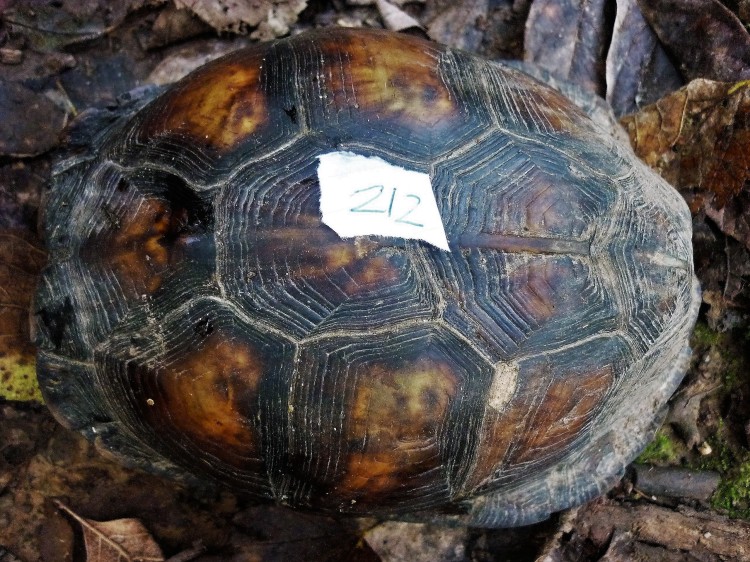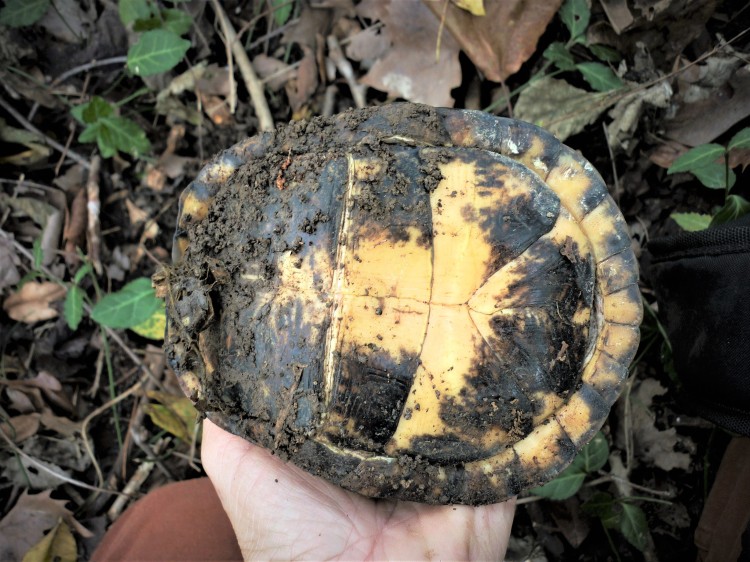
One of the more unique aspects of Beargrass Creek SNP is the healthy Eastern Box Turtle Terrepene carolina population. Why have they have continued to thrive in this small fragment of forest? In part they’re protected by a quirk of geography – a human-made barrier. Though the preserve is completely surrounded by neighborhoods, it’s “walled” on two sides by the channelized South Fork. This deep ditch serves as a kind of moat, preventing box turtle movement in the direction of nearby busy roads, while allowing for movement along the stream corridor. Habitat is good in the forest, with varied terrain, moist soils, springs, berry-producing plants and plenty of snails and earthworms. Despite being in the city, it’s box turtle heaven.

I decided to start collecting data on the preserve’s turtles in 2013, around the time I got serious about invasive plant removal. Working off-trail in the spring of that year, I met a surprising number of boxies just going about their business. Since then I’ve been privileged to observe these usually reclusive beings in many daily activities – eating, resting, mating, soaking in water, digging nests, laying eggs. Additionally, one was rescued one from the bird blind pond (they’re not water turtles), fourteen were removed from the path of earth moving machines (they can’t run away), one was accidentally dug up while hibernating (I put it back), and four were found dead (two had been run over near the preserve).

Since I’m a big procrastinator, it’s taken me this long to update my 2017 sightings, by printing the images and placing them with descriptions in a notebook. The image below is a typical page – written and drawn with turtle in hand, sometimes as a very unwilling participant! Over time the data I record becomes more interesting, as patterns start to emerge. A quick look at my 2017 notebook shows that 43 different Box Turtles were observed between 3/9 and 1/11
Some turtles were seen multiple times, but only counted once in the total. As time goes on a greater percentage of the turtles observed are also re-sightings from previous years, which complicates the data collecting. (I have yet to find an easy way to match up images of the same turtle from different years, other than parsing through the pictures and hoping some will look familiar).

Of the 43 sightings, 20 were female and 21 were male. I was surprised the gender ratio was so good; in previous years it looked more skewed, with consistently fewer females. Of course these numbers are an approximation at best, since all the encounters were random. My notes say that 15 turtles were “older”, 2 were “very old”, and 2 were young (less than a few years old). Turtles were judged to be old based on the condition of the carapace and plastron (top and bottom). As turtles age beyond 20 to 30 years, their shells become smoother with wear. A very old turtle is often larger than usual, with few discernable growth lines on its scutes (scales). For more on old turtles, see my 5/22 post “Old Ones of the Forest”.

Though most of the sightings were hasty affairs, a few of them stand out for one reason or another, so I’ll share them in this post.

The first turtle of 2017… This poor turtle has his own blog post dated 3/10, the day after I dug him up while planting Elderberry. There’s some question as to whether he had already emerged during the mild spring weather, and then gone back down again (read the post for more on this mystery). In any case, he was within a couple hundred feet of where he’d been seen several other times; proof that his home range is quite small.

This big guy is an older male; if box turtles have “alphas” he’d be one. A small percentage of male boxies have this kind of blocky square face and bright orange coloration. He lives very close to the turtle that I dug up, in a low meadow near a spring. Note the snail guts on his chin, I must have interrupted a meal.

A beautiful high domed female laid her eggs in an open meadow, just after a rain on 6/23. In the pic you can see how she used her back legs only to dig, and to feel if the hole was deep enough. When finished laying, she covered the hole so well there was no trace of the nest – all this without seeing what she was doing. Warm rainy days are “box turtle weather”; earthworms and snails are active, and the soil is soft for nest digging. Sadly, there’s a good chance raccoons found the nest – their abundance in urban ecosystems has a major impact on box turtle populations.

A small female, spotted on 8/12. She seemed unconcerned by my presence, maybe she had her eye on the snail. Many of the turtles I meet at BCSNP don’t pull into their shells, or at least not for long. Like the deer, they’ve seem to have adapted to a regular human presence. Note the healed damage on her carapace, it’s the sign of a past encounter with a predator that tried to chew in. Interestingly, these scars are usually found at the front of the carapace close to the turtle’s head.


The two boxies in the pics above have something in common – can you tell what it is? They’re actually the same turtle; the first pic was taken by my fellow Forest Steward Conrad. I made the connection between the two pics while working on the notebook, and it’s an example of how hard it can be to match up pics. Though the pattern was helpful, it was the unusual amount of carapace damage that clued me in. Every year I see more turtles that I’ve already met – a dot of green nail polish dabbed on their rear ends from the first encounter. Studies of box turtles have shown they stay very close to their small home range for the most part. The turtles in this forest confirm that; these homebodies are seldom more than a couple hundred feet from where they were previously spotted, and usually much less.

It’s not often I get to see a boxie eating, but on 9/23 I met this brightly patterned male with his purple mushroom. He was one of the shy ones, and pulled in his head when he saw me.

On 9/24 I met this very old female. She’s one of the largest box turtles I’ve ever seen; with dull muted colors and blended pattern she looks quite unlike the other turtles in this forest.

Readers will remember this striking older male from my 10/16 post “Tale of Two Turtles”. He’s one of those uniquely “unconcerned” turtles; the day I took this pic, 10/6, he was standing on my loppers when I came to get them.

The last turtle of the year (pic above and below) was found on 11/1, and he’d been burrowed down partially into his “form”, as you can tell from the muddy bottom. The green dot showed we’d met before, and his bold plastron pattern helped me locate him in the notebooks.

Though my box turtle record keeping can yield some good info on the preserve’s turtles, it’s no substitute for an actual research project using radio telemetry to track turtle movements. If such a study was done, my data would provide a good starting point. Meanwhile I’m putting a new 2018 turtle notebook in my backpack, to be ready when that first muddy turtle digs out.
scott woodward
Great blog. Look forward to future segments.
LikeLike
Susan Sheckler
Thank you so much for yet another enchanting lesson on The Forest.
LikeLike
Deany
Always love learning about the box turtle. Thank you!
LikeLike
Joan
Thanks RB! I really enjoyed meeting these fascinating creatures!
LikeLike
oneforestfragment
If it stays this warm, the early turtles will be waking up soon.
LikeLike